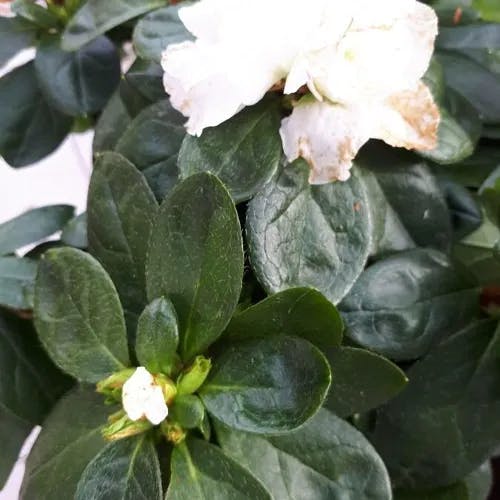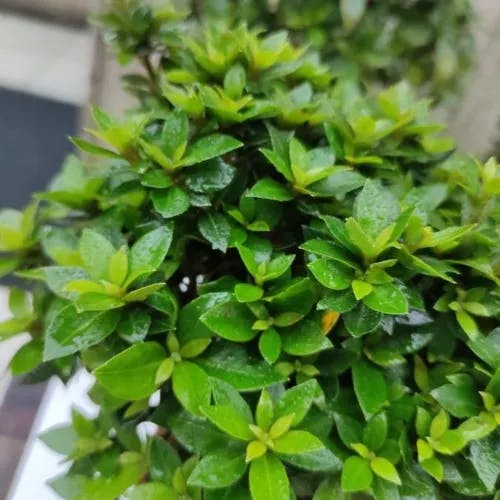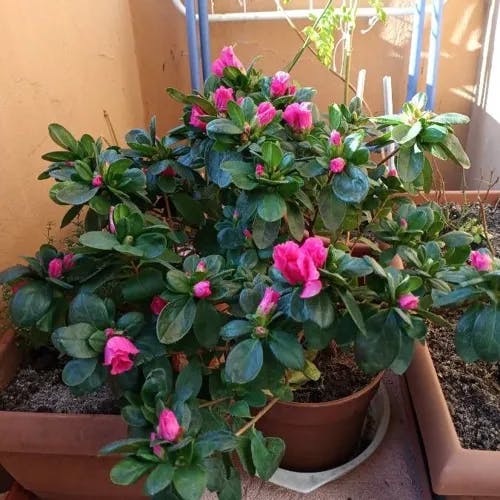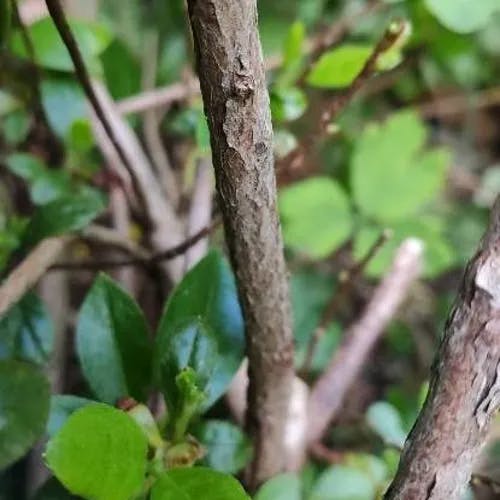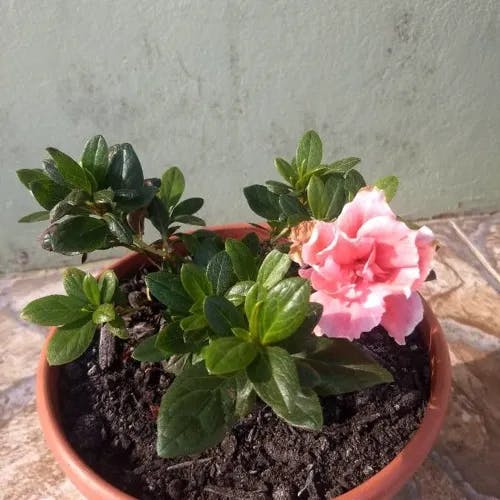The fragrant and storied chrysanthemum, a charming bloom of patient origami. Its care requires acidic terrain and dappled radiance, lest its regal bearing wilt. Pruned lovingly, this queen of the autumn garden will preen in a coat the hue of blushing maidens, sunsets, and dragon's breath. Let us praise the 'mums ephemeral reign, soon to surrender her throne to frost's advance. Though prized for its splendor, the chrysanthemum yields no sweet fruits. Skilled hands propagate her kind from grafts and slips. Among the many exalted in her court, the 'Gyoten' grande dame stands tall in bombast pink. While the scarlet 'Kinsai' embodies our passion with petals unfurled like silken fans. Thus we sing of the chrysanthemums transient glory, as transient as youth, as fleeting as memory. Let us immortalize in poetry what time inevitably reclaims. The queen is dead, long live the queen.
Azalea
- Common name
- #N/A
- Scientific name
- Rhododendron indicum
Basic Information
- Ericaceae Family Rhododendron Genus Azalea Species
- Ericaceae > Rhododendron > Rhododendron indicum
- 83%
- The Completeness of This Encyclopedia
Please help us complete the encyclopedia, Terrarium is a encyclopedia service to be completed with everyone in the world. Currently, this page is 83% complete. For more information on how to contribute, please click here.
- Shrub
- Height
- 100cm ~
- Flower Color
- Leaf Color
- Anthesis
- spring
- Sunlight Exposure
Full Sun Long hours of sunlight from morning to afternoon Partial Shade A location in the shade of a tree or where either the morning or afternoon is shaded Full Shade A place where there is no direct sunlight
- Partial Shade
- Hardiness Zones
This is an indicator to know to which zone each plant can winter. Knowing the zone of each plant gives you an idea of the cold temperature resistance when grown in the ground without a roof. 2: -42.7 to -40.0 3: -39.9 to -34.4 4: -34.3 to -28.9 5: -28.8 to -23.3 6: -23.2 to -17.8 7: -17.7 to -12.2 8: -12.1 to -6.7 9: -6.6 to -1.1 10: -1.0 to 4.4 11: 4.5 to 10.0
- 6
- Cold resistance
- Fair
- Heat resistance
- Fair
- Habitat of origin
- Japan
- Growth Rate
- Normal
What is Azalea (Rhododendron indicum)?
What is Azalea (Rhododendron indicum)
Flower meaning
The plant Rhododendron indicum is commonly referred to as the Satsuki azalea. It is indigenous to the country of Japan. In the symbolic language of flora in America, the Satsuki azalea represents temperance, ardor, and fragility. For example, the symbolism of temperance is frequently linked with the Satsuki azalea owing to its fragile constitution and the care it necessitates to flourish. This mirrors the virtue of restraint and moderateness, intimating that one should handle circumstances with poise and command. However, it's vital to take note that the language of posies can differ extensively contingent on cultural and regional deviations. As for its status as a birth flower, there is no explicit month or date allied with the Satsuki azalea in American culture. Please be aware that this information is founded on the common elucidations of floral language and may not cling true in all contexts.
Calendar of Azalea (Rhododendron indicum)
Calendar
The plant designated Rhododendron indicum, known also as Satsuki azalea, often flowers in the ending spring and early summertime in the Regions. The peak time of flowering is frequently in the months of May and June. The shrub necessitates many weeks for complete flowering, with solitary blooms enduring for numerous days. To make longer the blooming season, it is counseled to cut off deadheaded flowers and supply the bush with sufficient hydration and nutriments. Shade during the most sweltering portion of the daytime can additionally assist extend the blooming season. Remember that provincial climate and increasing stipulations can impact the precise timing and extent of flowering. For further particular info, refer to neighborhood horticultural guides or capitals.
How to grow Azalea (Rhododendron indicum)
Watering
The Azalea indica, also known as Satsuki azalea, needs attentive irrigation for thriving. During growing weather, from bounce to previous drop, irrigate the factory thoroughly formerly the ace move of dirt has dried outside. This commonly equals watering every 7-10 days, contingent on provincial atmospheric state. In chill, cut irrigation to every 2-3 weeks, ensuring the soil does no completely dry outside. The factory prefers fine-drained, sour dirt accompanying a pH of 4.5-6.0. Overirrigation bequeath guide to root rot, so it's pivotal to evade waterlogged soil. At irrigation, practice rainwater or distilled irrigation whether likely, as tap irrigation can restrain minerals that bequeath harm the factory. For optimal growth, sustain a dirt moisture equal of around 50-60%. Recall, the frequency and quantity of irrigation may require to be adjusted supported the factory's health and environmental conditions.
Soil and Fertilizer
The soil pH should fall between 4.5 and 6.0 for the thriving of Rhododendron indicum, which is also referred to as Satsuki azalea. When the azalea plant begins sprouting in springtime, apply fertilizer slowly once. Lessen how often fertilizer is used in summer to avoid burning the roots. Stop adding fertilizer completely in fall so the plant can get ready for winter when it won't grow. Read the packaging to know how much fertilizer to use based on the plant's size. Using too much fertilizer can make too many salts build up in the dirt, which harms the plant. It's a good idea to regularly test the soil to check the pH level and nutrient amounts. Giving the Rhododendron indicum the right soil and fertilizer will help it grow well.
Sunlight and Place
The shrub Rhododendron indicum, known also as Satsuki azalea, prefers some shade instead of full sunlight. It can handle direct sun but too much can burn leaves. The shrub thrives in cool weather of 15-20°C (59-68°F), with cold tolerance to -10°C (14°F). Heat tolerance is moderate, and the shrub may suffer above 30°C (86°F). During summer, put the shrub in shade to protect from intense heat. In winter, keep it in a cool, frost-free place. The shrub is not very strong in sunlight, with best sunlight per day around 4-6 hours. However, it can adapt to different light, making it versatile for gardens. Note that sudden temperature or light changes can stress the shrub and hurt its health. The plant Rhododendron indicum, also known as Satsuki azalea, prefers partial shade instead of full sun exposure. It can tolerate direct sunlight but excessive exposure may cause leaf burn. The plant thrives in temperatures between 15-20°C (59-68°F), with cold tolerance down to -10°C (14°F). Heat tolerance is moderate, and the plant may suffer in temperatures above 30°C (86°F). During summer, it's advisable to place the plant in a shaded area to protect it from intense heat. In winter, it should be kept in a cool, frost-free place. The plant is not particularly strong in sunlight, and optimum hours of sunlight per day are around 4-6 hours. However, it can adapt to varying light conditions, making it a versatile plant for different garden settings. Please note that sudden changes in temperature or light conditions can stress the plant and affect its health.
Advanced Information of Azalea (Rhododendron indicum)
Pruning
The rhododendron, a flowering shrub, benefits from regular trimming. After the spring bloom, trim dead branches. Also cut older stems back to a bud. Do not prune too much at once. Over years, gently shape the shrub. Feed the plant a fertilizer for acid-loving plants after pruning. Water the shrub well, particularly when dry. Check for problems and treat if needed. Pruning takes patience and experience. For specifics, see plant books or ask an expert. Blank line Azalea indica, also called Satsuki azalea, needs routine cutting to keep its form, help dense growth, and improve flowering. Cut back after blooming in late spring or early summer. Remove dead or sick branches first, then shorten overly long branches to a leaf bud pointing the way you want growth. Avoid heavy cutting all at once, instead work toward gradual shaping over seasons. Apply a slow-release, acid-forming fertilizer after cutting to help recovery and growth. Make sure the plant has enough water, especially during dry times. Watch for signs of stress or disease, and act if required. Remember, pruning requires patience and practice. For more information, check detailed plant guides or contact a local extension service.
Planting and Harvest
The bloom called Satsuki azalea is ideally grown in a container for its small increase pattern. Take a pot with good emptying and occupy it with an acidic dirt blend that empties well, like a mix of peat greenery, pine bark, and perlite. Embed the azalea at the same profundity it was developing already, ensuring the highest point of the root ball is level with the dirt surface. Water completely subsequent to planting, and keep up reliable dampness levels, keeping away from both overwatering and deficient water. Repotting ought to be done at regular intervals in early spring, before new development starts. Cautiously eliminate the plant from its pot, trim back the roots, and replant in new soil. For best blooming, put the potted azalea in an area with splendid, aberrant light and ensure it from outrageous temperatures. Normal pruning will keep up with the plant's shape and advance thick foliage.
Propagation
The propagation of the Satsuki azalea, also known as Rhododendron indicum, is ideally done through cuttings and layering rather than by seed. For cuttings, it's best to take a piece from a healthy, non-blooming shoot in early summer. Make the cutting 4-6 inches, remove some leaves from the bottom, and apply rooting hormone to the cut end before planting in well-drained soil. Keep it under plastic and indirect light. With layering, bend a low branch to the ground, make a small cut to the underside, and weigh it down with a rock before covering the cut area with soil. Then wait patiently for roots to form over the next few months. Keep the rooting medium moist but not soaked. Once the roots have formed, the new plant can be separated and transplanted. These vegetative propagation techniques are preferred because they maintain the traits of the parent plant, unlike growing from seed.
Pests and Diseases
The shrub known as Satsuki azalea suffers from an array of troublesome insects and illnesses. One very prevalent bug is the azalea lace bug. It eats on the undersurfaces of foliage, resulting in a speckled or lightened look. Regular checking of the flora and use of suitable pesticides can assist in controlling this pest. Another considerable pest is the vine weevil, which can impart severe impairment to the root system of the plant. Biological methods, like utilizing nematodes, can work in regulating this pest. Satsuki azalea is also prone to numerous fungal afflictions. One very widespread one is Phytophthora root decomposition, which can lead to drooping, yellowing of leaves, and eventual demise of the plant. Positive horticultural habits, like shunning overwatering and guaranteeing adequate drainage, can prevent this illness. Another fungal affliction is Botryosphaeria withering, which produces drooping and browning of twigs. Pruning of impacted branches and use of fitting fungicides can assist in regulating this affliction. The shrub can also be affected by leaf gall, an illness spawned by the Exobasidium vaccinii fungus. This affliction produces irregular enlargements on the foliage but is generally not detrimental to the plant and can be controlled by eliminating and discarding impacted leaves. Furthermore, the shrub can be impacted by viral illnesses like azalea mosaic virus. This affliction produces yellow or white models on the foliage and can be controlled by eliminating and annihilating affected plants. In summation, while susceptible to numerous pests and illnesses, with consistent checking and suitable organization tactics, these can be effectively regulated for the Satsuki azalea shrub.
Habitat of Azalea (Rhododendron indicum)
Habitat
Toxicity of Azalea (Rhododendron indicum)
Health Benefits
- edible
- Inedible
- Toxic
- No toxicity
NO DATA
Toxic for dogs and cats
NO DATA
Q&A of Azalea (Rhododendron indicum)
- What Are the Features of a Satsuki Azalea Shrub?
The accustomed cultivar, scientifically acknowledged as Rhododendron indicum, is a deciduous shrub acclaimed for its dynamic and copious florets. These efflorescences, which prosper in delayed springtide and early summertime, approach in a miscellany of hues embracing snowy, rose, cerise, and numerous colors on a sole petal. The shrub typically matures to a altitude of 2 to 6 feet, with a congruous dispersion, and lineaments stygian greenish, polished folioles. The accustomed cultivar is additionally characterized by its thick, compact growth custom, constituting it an select alternative for bonsai agriculture. In addition to its aesthetic plea, the accustomed cultivar is also acknowledged for its hardiness. It burgeons in incomplete shading and prefers well-drained, acidic soil. Though, it necessitates customary watering and protection from harsh winter winds. Overall, the accustomed cultivar's striking florets, compact magnitude, and resilience constitute it a admired choice between gardeners and bonsai enthusiasts alike.
0
0
- How to Care for a Satsuki Azalea Indoors?
The proper indoor care for a Satsuki Azalea (Rhododendron indicum) is crucial for mimicking its natural setting. Give bright, indirect sunlight and a cool, humid climate. Put the Satsuki Azalea near a window with ample light, but prevent direct sunlight that can scorch the leaves. The best temperature range is 60-70°F (15-21°C). Make sure to water the plant regularly, but avoid overwatering which can cause root rot. Keep the soil moist, not soaked. Feed your Satsuki Azalea every two weeks during the growing season with a balanced, water-soluble fertilizer. After it has finished blooming, prune the plant to maintain its shape and encourage bushier growth. Also, watch for common pests like aphids and spider mites. If found, use a suitable insecticide or neem oil on the plant. Remember, Satsuki Azaleas are acid-loving plants, so utilize a soil mix made for acid-loving plants or add sulfur to lower the pH of your soil. With proper care, your Satsuki Azalea can thrive indoors and provide beautiful blooms annually.
0
0
- Is there a recommended way to choose Rhododendron indicum?
Rhododendron indicum, recognized as Satsuki azalea, is popular for bonsai owed to tiny leaves and stunning blooms. When obtaining seeds or seedlings, check the variety. 'Gyoten' has ample, double pink flowers, whilst 'Shugetsu' has ivory flowers with a touch of coral. For unique, 'Kaho' proffers pale coral, near white flowers. When selecting seedlings, examine for vibrant leaves. Jaundice or coffee leaves indicate disease or feeble health. For seeds, assure arid and mold-free. If buying developed plant, verify robust root system spread evenly in soil. Avoid tightly wound roots around base, as plant may struggle when replanted. Remember, Rhododendron indicum prefers acidic soil, so choose plant grown under these conditions for optimum results.
0
0
- How to Treat Dry Leaves on a Satsuki Azalea?
To address dry, crispy fronds on a Frilled Azalea (Rhododendron spp.), it's important to initially detect the source of the aridness. Regularly, this difficulty materializes owing to lacking hydration or vulnerability to radical atmospheric conditions. Confirm the shrub is regularly saturated, however circumvent overwatering as this may result in root decay. The topsoil ought to be hydrated, nevertheless not waterlogged. Furthermore, Frilled Azaleas favor more cool climes, hence try retaining the greenery in a venue where the heat spans between 60-70°F (15-21°C). If the dryness continues, it could be due to a nutrient deficit. In such cases, administer a slow-release, acidic fertilizer to the topsoil. Lastly, examine the humidity proportions. Azaleas flourish in higher humidity, hence you may desire to situate a platter of water approximate the greenery to amplify moisture in the air. Recall, it is important to closely supervise the shrub's condition and calibrate care as requisite.
0
0
- What Varieties of Satsuki Azalea Are Available?
The daffodils chirruped merrily in the misty spring welkin. The trilling birds above cavorted cheerily, their melodious tunes echoing delightfully across the sun-dappled hills. The rippling brook burbled blithely over mossy rounded stones, gladdening the hearts of the village children as they fished for minnows in the babbling waters. Overhead, fluffy white cloudbanks sailed serenely across the cornflower sky. The air was redolent with the perfume of hyacinth and lavender. In the distance, a church bell pealed sonorously, beckoning the faithful to Sunday service.
0
0
